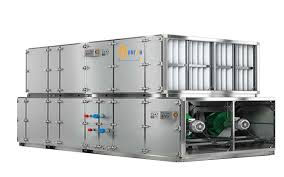Efficient Cooling Strategies for Modern Buildings
- cyruscrafts shop
- Jul 14
- 4 min read
As cities expand and building footprints shrink, the demand for flexible, energy-efficient cooling solutions continues to grow. Whether it’s a commercial office tower, a residential complex, or a data center, maintaining indoor thermal comfort without compromising architectural space or environmental goals is a major challenge for today’s HVAC designers.
Traditional water-based systems and centralized cooling plants offer strong performance, but they often require large mechanical rooms, cooling towers, and substantial maintenance infrastructure. For many modern buildings—especially those in urban areas with space limitations or water scarcity—alternative approaches must be considered.
This is where the Air-cooled chiller enters the conversation as a practical and effective solution.
What Is an Air Cooled Chiller?
An air cooled chiller is a type of refrigeration system that removes heat from a building by circulating chilled water through indoor air-handling units or fan coils—and then rejecting that heat into the ambient air through coils and fans, without using a cooling tower. Unlike water-cooled systems, it uses air (instead of water) to disperse heat, which significantly simplifies installation and maintenance.
Air cooled chillers are typically installed outdoors—on rooftops, terraces, or ground-level pads—and come in various capacities to suit small commercial buildings as well as large-scale infrastructure.
Why Choose an Air Cooled Chiller?
The growing popularity of air cooled chillers can be attributed to a range of advantages that align well with contemporary building demands:
1. No Need for Cooling Towers
By using air instead of water for heat rejection, these systems eliminate the need for cooling towers, water pumps, and related infrastructure. This not only reduces space requirements but also lowers water consumption—an increasingly important factor in regions facing water shortages.
2. Simplified Installation
Air cooled chillers are often packaged units, pre-assembled and ready to connect. This makes installation faster and less complex, especially in retrofit projects or where mechanical room space is limited.
3. Lower Maintenance
Because there’s no cooling tower to clean, treat, or manage, air cooled chillers require less ongoing maintenance. There are fewer risks of water treatment issues, scaling, or microbial contamination.
4. Ideal for Urban and Rooftop Applications
Thanks to their self-contained design and outdoor installation flexibility, air cooled chillers are perfect for dense urban environments where interior space is at a premium.
Common Applications
Air cooled chillers are used across a wide range of industries and building types, including:
Commercial office buildings
Hotels and resorts
Hospitals and clinics
Educational institutions
Data centers
Industrial process cooling
Their ability to deliver chilled water to a variety of terminal devices (like fan coil units or AHUs) makes them highly adaptable to many system designs.

How Air Cooled Chillers Work
The operation of an air cooled chiller follows a standard vapor compression cycle:
Evaporator: Warm water from the building passes through the evaporator coil, where it is cooled by refrigerant.
Compressor: The refrigerant absorbs heat from the water and becomes a high-pressure gas.
Condenser Coils and Fans: The hot refrigerant gas is then passed through condenser coils, where ambient air (drawn by fans) removes the heat.
Expansion Valve: The refrigerant is then expanded to a low-pressure state, ready to absorb more heat in the evaporator.
This cycle continues, delivering consistent cooling without relying on water-based heat rejection systems.
Factors to Consider Before Choosing an Air Cooled Chiller
While air cooled chillers offer many benefits, they’re not the ideal solution for every project. Key factors to consider include:
Climate: In extremely hot climates, air cooled chillers may become less efficient compared to water-cooled systems.
Noise: Fans and compressors can generate noticeable noise; noise barriers or low-noise models may be required in sensitive areas.
Energy Efficiency: While modern units are highly efficient, water-cooled systems generally offer better performance in large-scale applications. Energy modeling can help determine the best option.
That said, advances in technology—such as variable-speed compressors, high-efficiency fans, and intelligent control systems—have significantly narrowed the performance gap.
Sustainability and the Future of Air Cooled Chillers
As the construction industry continues to focus on reducing environmental impact, air cooled chillers are evolving to support sustainability goals:
Use of Low-GWP Refrigerants: Many manufacturers now offer systems using refrigerants with a lower global warming potential (e.g., R-32 or R-454B).
Integration with Renewable Energy: Rooftop installations make it easier to integrate with solar energy systems.
Smart Controls and Monitoring: Modern chillers often include IoT-enabled monitoring systems that optimize performance and detect faults in real time.
In regions facing rising temperatures and water scarcity, air cooled chillers are positioned to become the preferred choice for efficient and responsible cooling.
Conclusion
As buildings become more compact and sustainability takes center stage in design decisions, HVAC solutions must adapt accordingly. The air cooled chiller offers a well-balanced option—minimizing complexity and water usage while delivering dependable cooling performance across a wide variety of applications.
By understanding its advantages, limitations, and integration options, architects, engineers, and building owners can make informed choices that support both operational goals and long-term environmental responsibility.



Comments